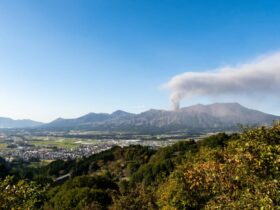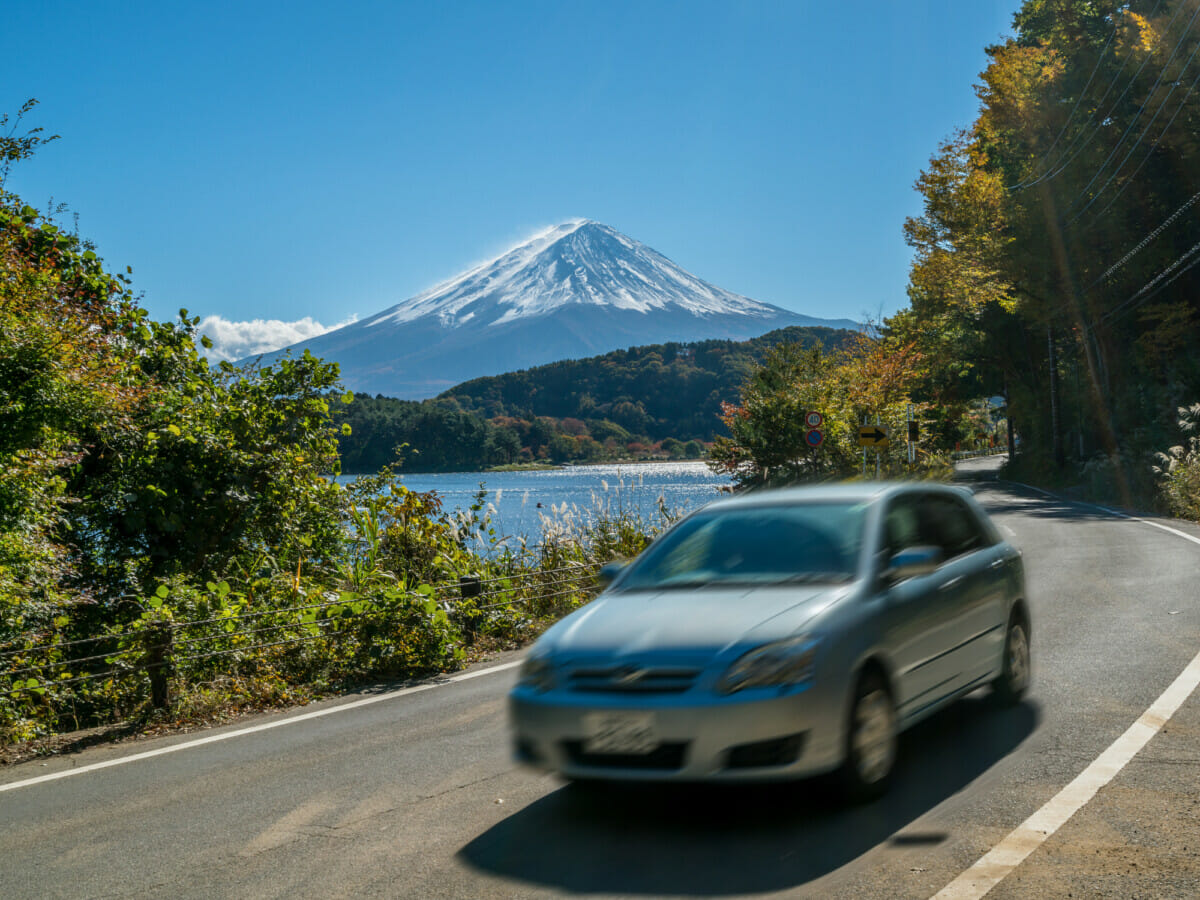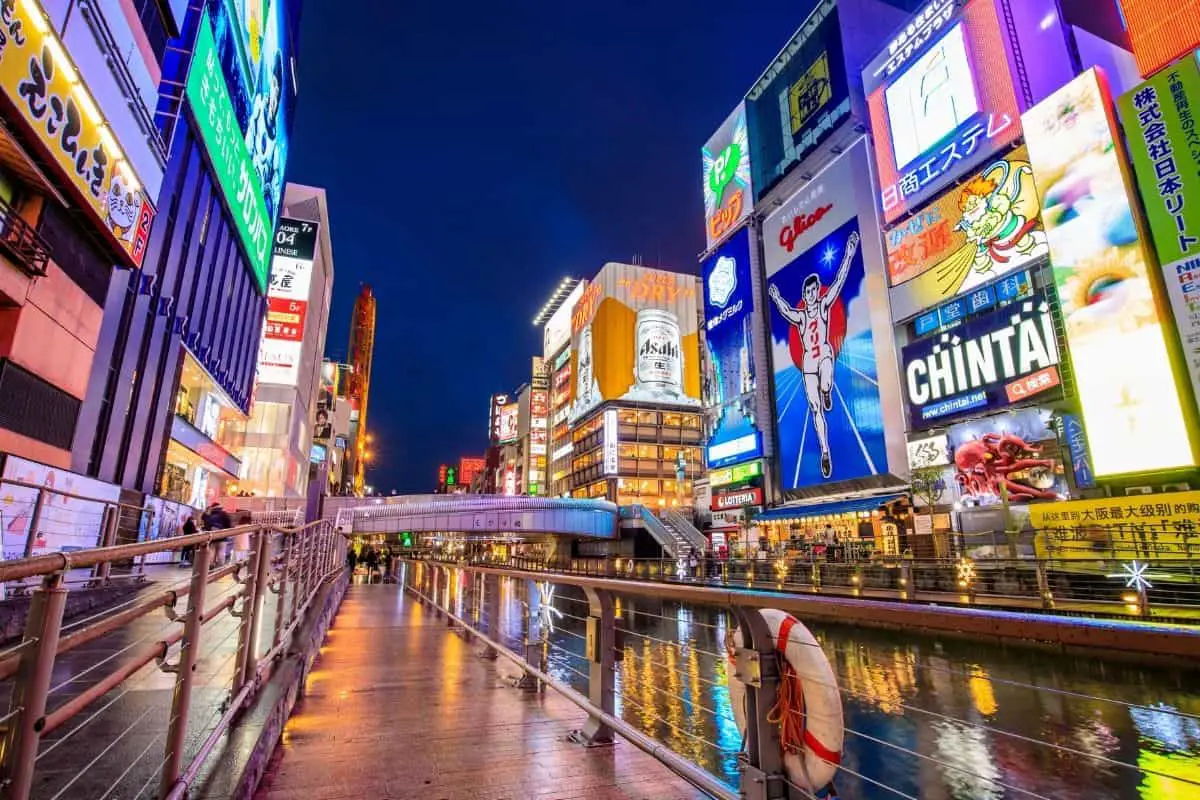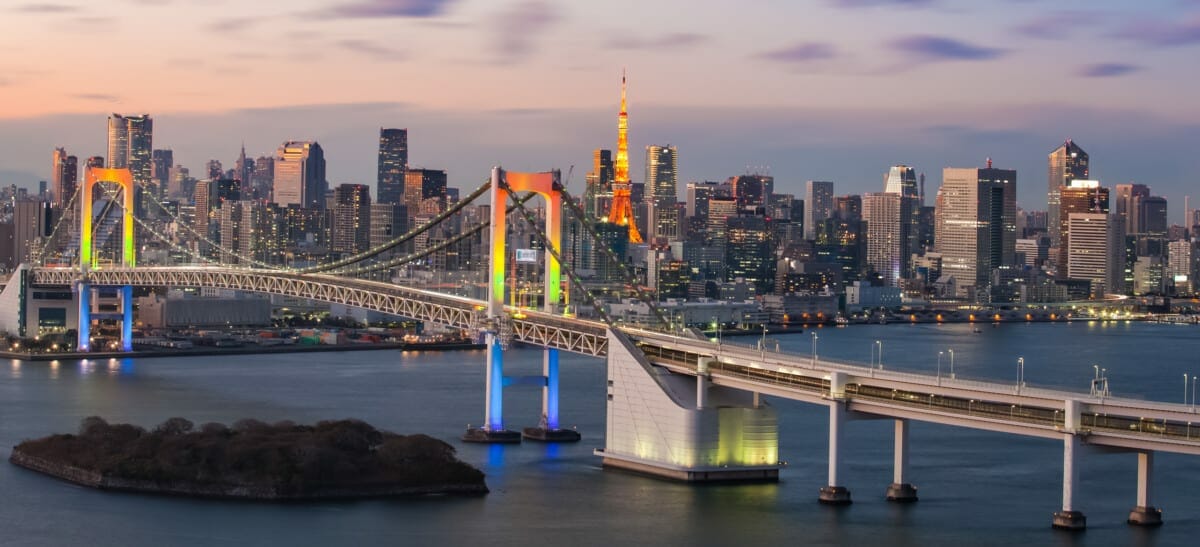Nestled among the mountains of Western Honshu, the ancient city of Kyoto stands as a testament to Japan’s rich tapestry of history and culture. Founded in the 8th century, Kyoto, or “Capital City” as its name translates, served as the imperial capital of Japan for over a millennium.
With its intricate weave of palaces, temples, and traditional wooden houses, Kyoto provides a window into the nation’s soul, a place where one can trace the delicate brushstrokes of time.
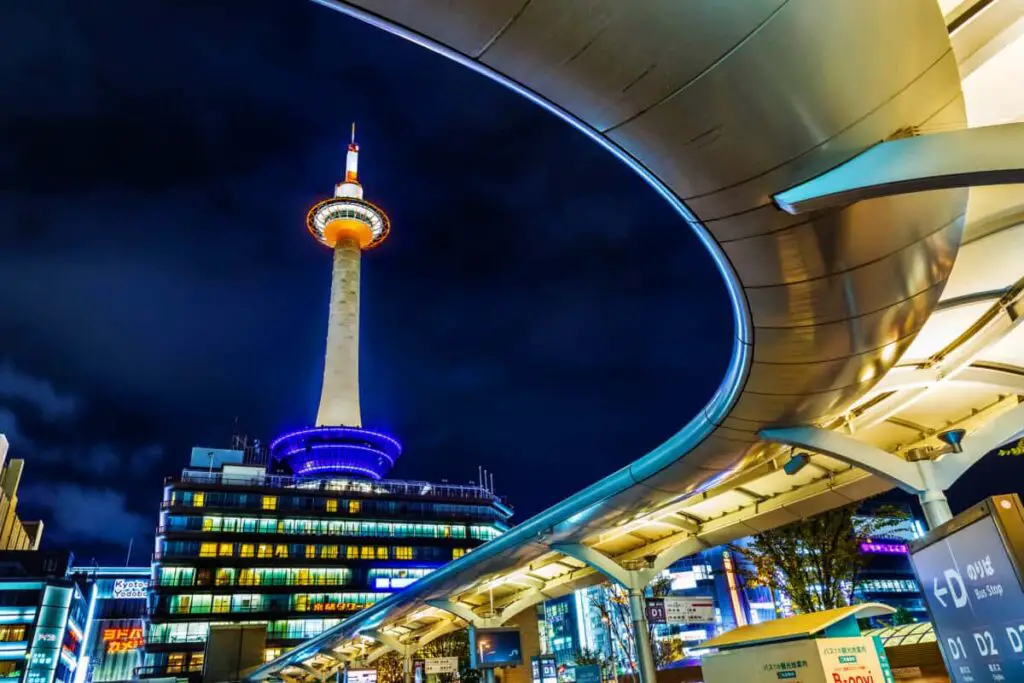
Kyoto’s significance is not solely anchored in its historical milestones. It is a living city, ever-evolving, yet deeply rooted in its traditions. Here, modernity and antiquity coalesce, creating a unique blend that resonates with both locals and visitors alike.
But if there’s one season that truly encapsulates Kyoto’s ethereal beauty, it’s autumn. As the summer’s heat gives way to crisp, cooler days, the city undergoes a magical transformation. The once verdant landscapes shift to a symphony of reds, oranges, and golds, painting a mesmerizing tableau.
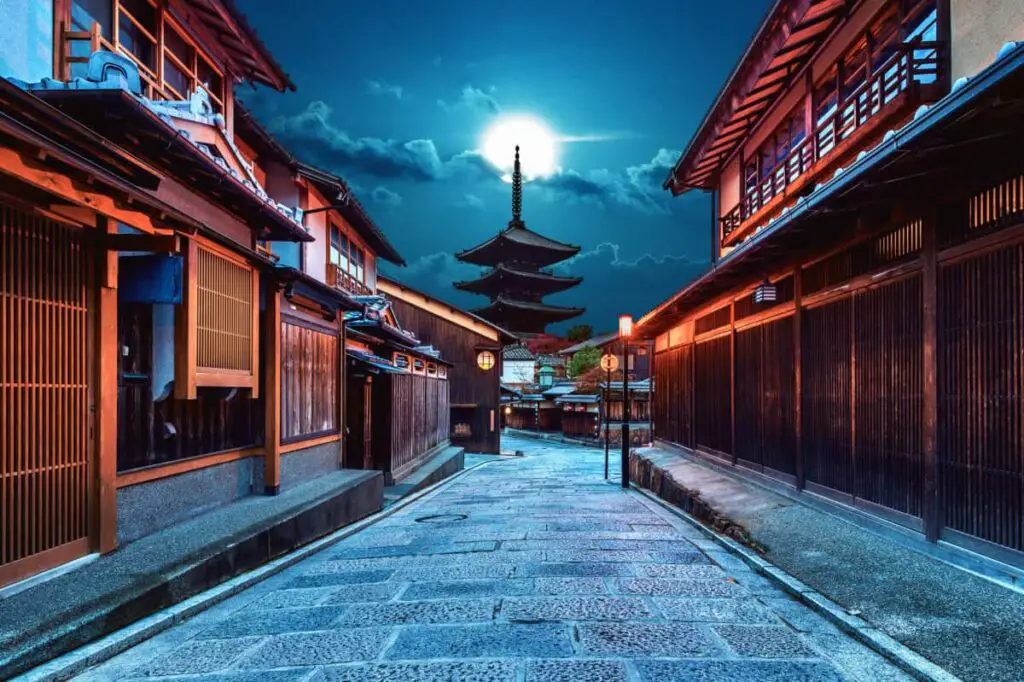
Streets lined with cherry trees, which in spring blush with delicate pink blossoms, now flaunt vibrant autumnal hues.
The iconic Kiyomizu-dera, overlooking the city, becomes a vantage point to a sea of fiery maples. Temples and shrines, already imbued with a sense of serenity, take on an even deeper tranquility amidst the fall foliage.
This magic of autumn in Kyoto isn’t just a visual treat; it’s an experience that engages all the senses.
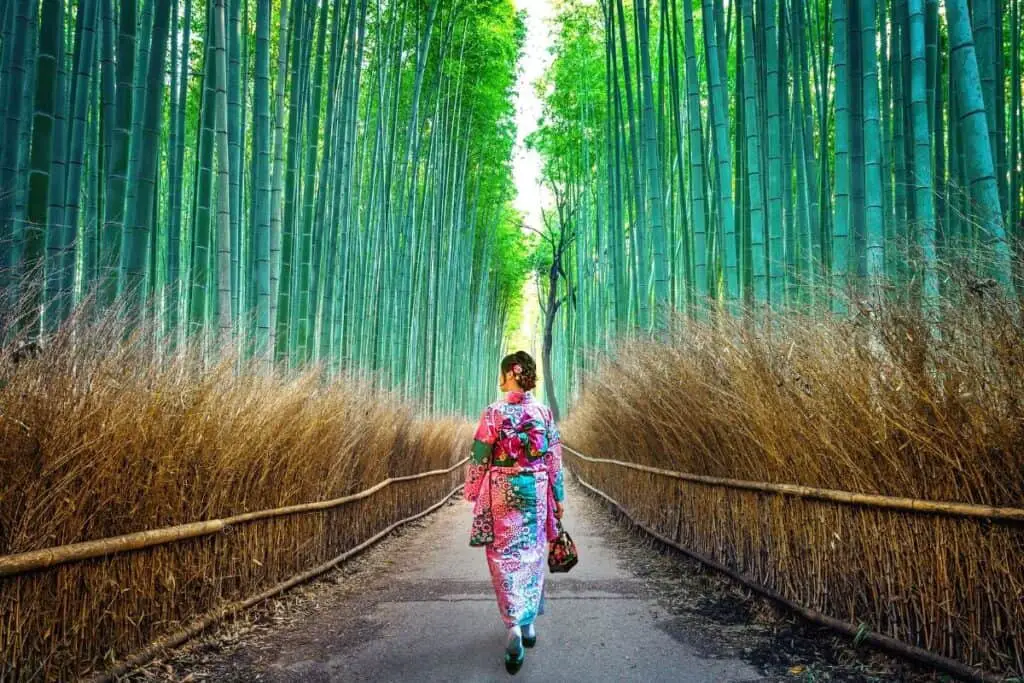
The rustle of fallen leaves underfoot, the scent of roasted chestnuts filling the air, and the soft light of lanterns illuminating evening pathways provide a sensory immersion into a world where nature and culture entwine in perfect harmony.
As we embark on this journey through Kyoto’s autumnal splendor, let us be reminded of the transient nature of beauty and the importance of cherishing every moment.
For just as the fiery hues of the season eventually give way to winter’s grip, our experiences in this historical city are fleeting, making them all the more precious. Welcome to Kyoto in the fall – a celebration of history, culture, and nature’s grandeur.
Temples and Shrines
Kiyomizu-dera Temple: Overview: Perched on the eastern hills of Kyoto, Kiyomizu-dera, a UNESCO World Heritage Site, offers an enchanting panoramic view of the city.
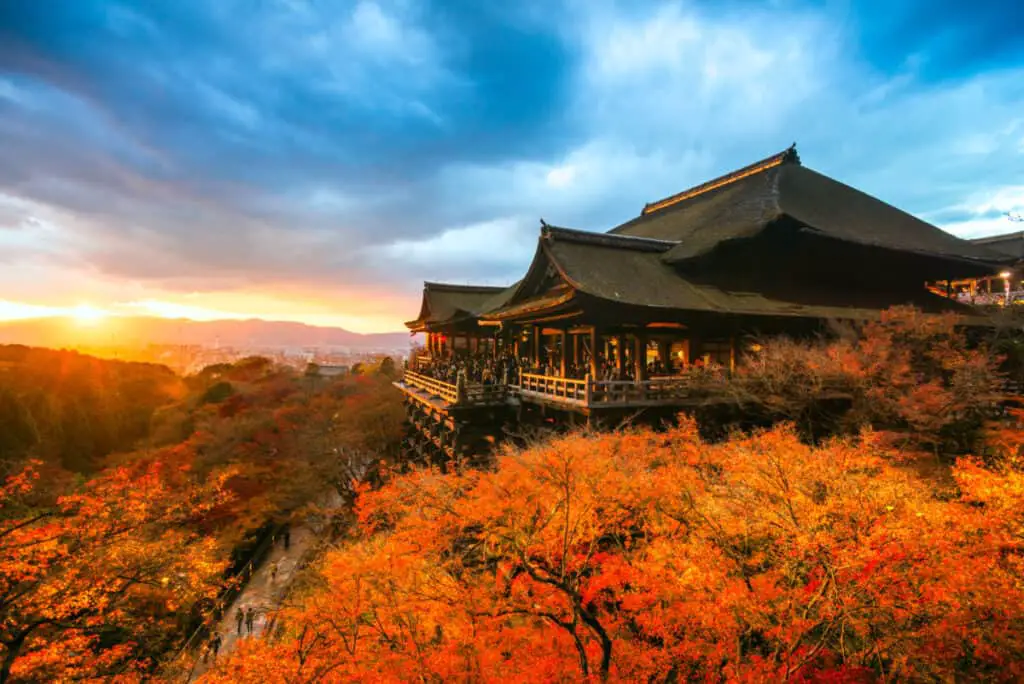
Beyond its breathtaking autumn vistas, the temple’s wooden terrace and Otowa Waterfall draw pilgrims and tourists alike. How to Reach:
- By Bus: From Kyoto Station, take City Bus number 100 or 206. Exit at “Gojo-zaka” or “Kiyomizu-michi” stops. A 10-minute uphill walk along the charming historic streets leads directly to the temple.
- By Train: The Kiyomizu-Gojo Station on the Keihan Railway Line is about a 20-minute walk from the temple, taking you through picturesque neighborhoods.
Tofuku-ji Temple: Overview: Situated in the southeastern quadrant of Kyoto, this temple is renowned for the Tsuten-kyo Bridge which offers unmatched views over a valley teeming with lush maple trees. How to Reach:
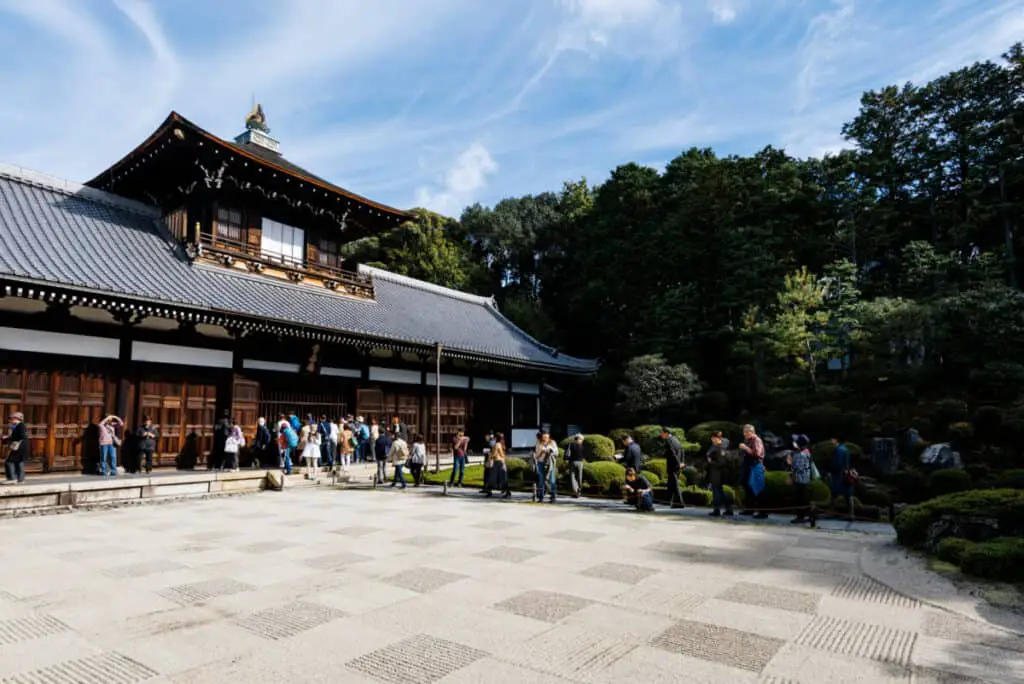
- By Train: Easily accessible via Tofukuji Station, which is on both the JR Nara Line (a quick stop from Kyoto Station) and the Keihan Main Line. The temple is a 10-minute walk, well-signposted.
Eikando Zenrin-ji Temple: Overview: Eikando is a treasure during the autumn season. With its iconic “thousand autumn maple tree” and serene pond, it’s a spot that mesmerizes both the mind and soul. How to Reach:
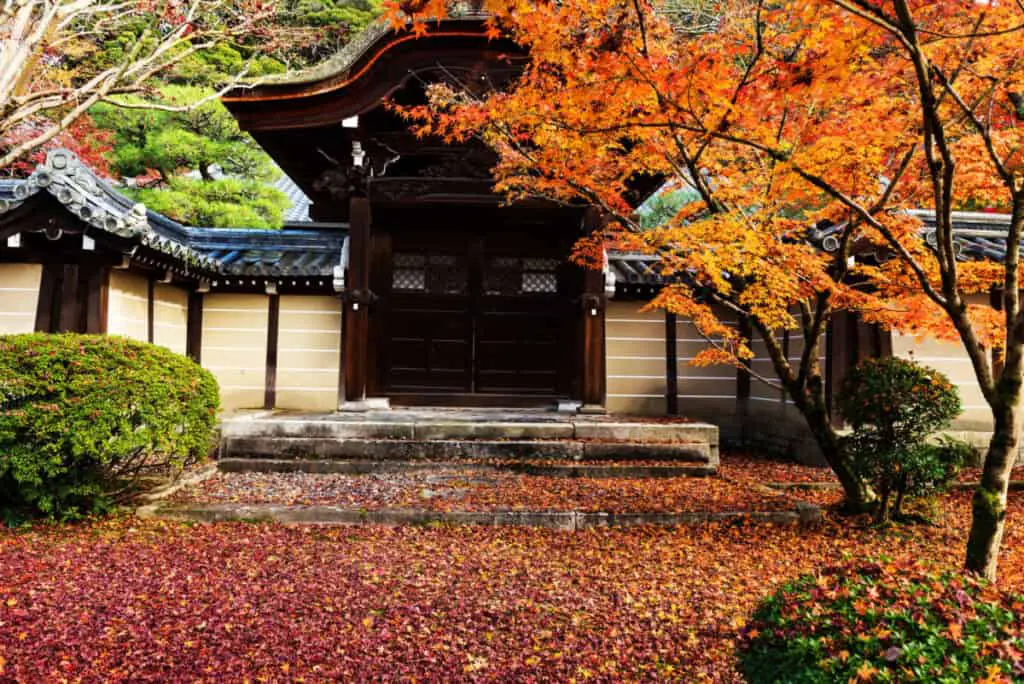
- By Bus: City Bus number 5 from Kyoto Station is the most straightforward option. Alight at “Nanzen-ji Eikando-michi” and the temple is a 5-minute walk.
Rurikoin Temple: Overview: Not as frequented by the masses, this temple provides a tranquil atmosphere, enhanced in autumn by the mesmerizing reflection of vibrant leaves on its polished tabletops. How to Reach:
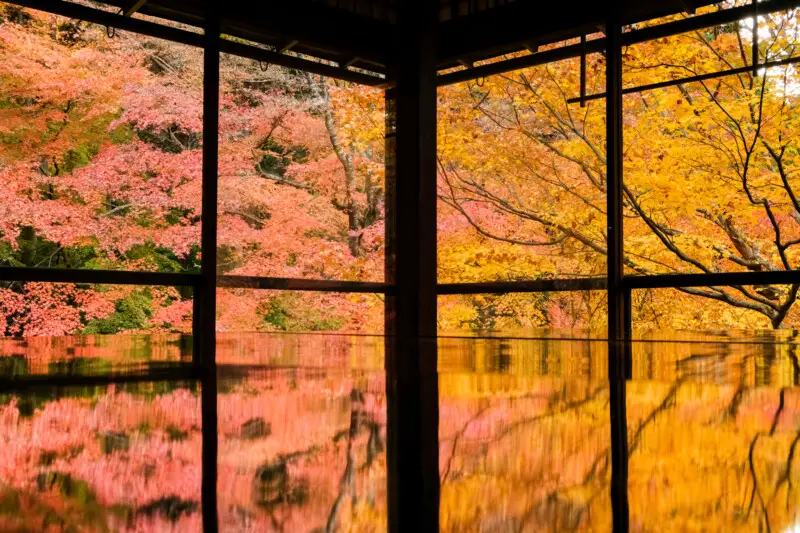
- By Train: Head to the Eizan Train Line from Kyoto Station and get off at Yase-Hieizanguchi Station. Rurikoin is a scenic 5-minute walk from the station.
Daigo-ji Temple: Overview: An ancient temple complex with a storied history, its five-story pagoda amid the autumn foliage is a scene that encapsulates the essence of Kyoto’s autumn. How to Reach:
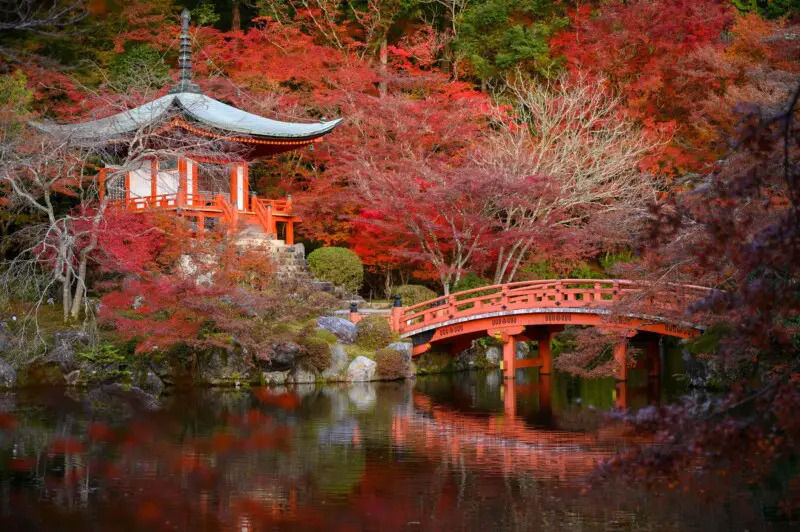
- By Subway: The Tozai Subway Line will take you to Daigo Station. From there, follow the signs through a quaint neighborhood; the temple is about a 15-minute walk.
Shimogamo Shrine: Overview: As one of Kyoto’s oldest Shinto shrines, its grounds transform in the fall, particularly with the striking golden hues of the ginkgo trees. How to Reach:
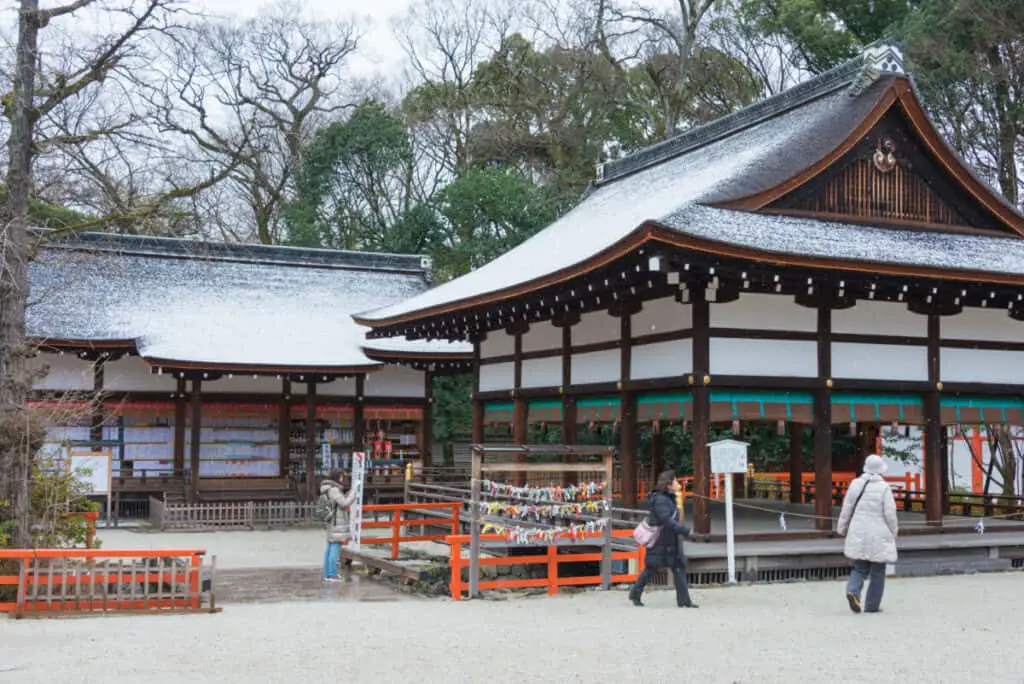
- By Bus: Opt for City Bus number 4, 205, or 93 from Kyoto Station. Disembark at the “Shimogamo Jinja-mae” stop. The shrine’s entrance is a short, well-marked 5-minute walk.
Remember, during peak tourist seasons, especially autumn, Kyoto’s transport can be busier than usual. It’s always good to start early and check for any transport updates or changes during your visit.
Gardens and Parks
Maruyama Park: Overview: Nestled in the heart of Kyoto’s Gion district, Maruyama Park is widely known for its cherry blossom celebrations in spring.
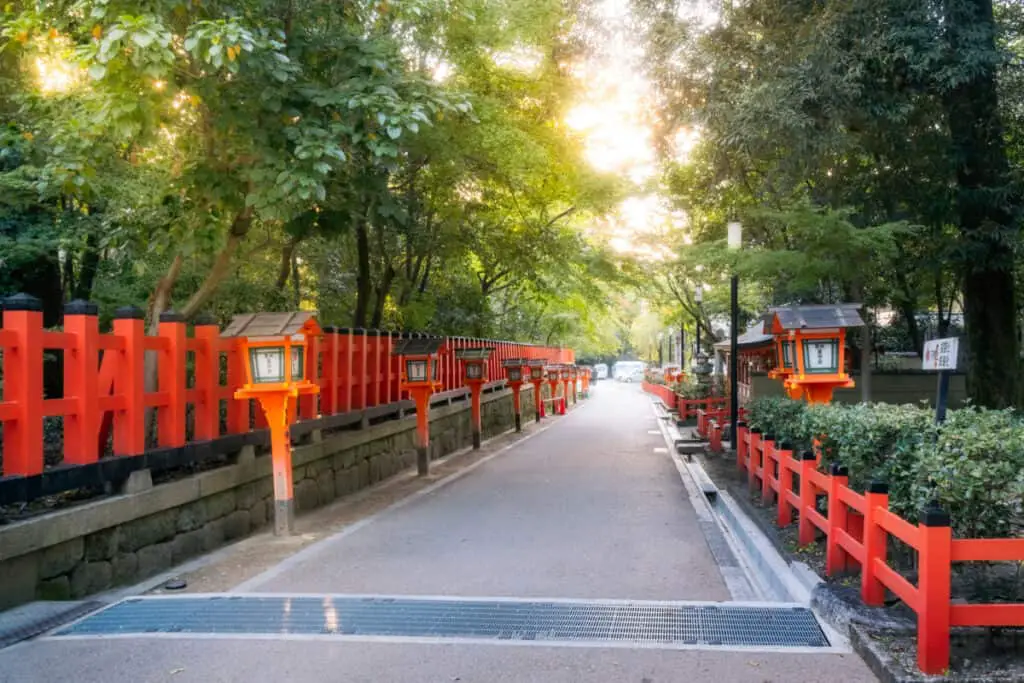
However, come autumn, the park undergoes another captivating transformation. The numerous trees turn into shades of red, orange, and yellow, complementing the park’s central pond and offering a picturesque landscape.
Don’t miss the scenic night illuminations during peak foliage season. How to Reach:
- By Bus: From Kyoto Station, take bus number 100 or 206 and get off at Gion bus stop. The park is just a short walk away.
Shoseien Garden: Overview: Also known as Kikoku-tei, Shoseien Garden is a scenic haven located in downtown Kyoto.
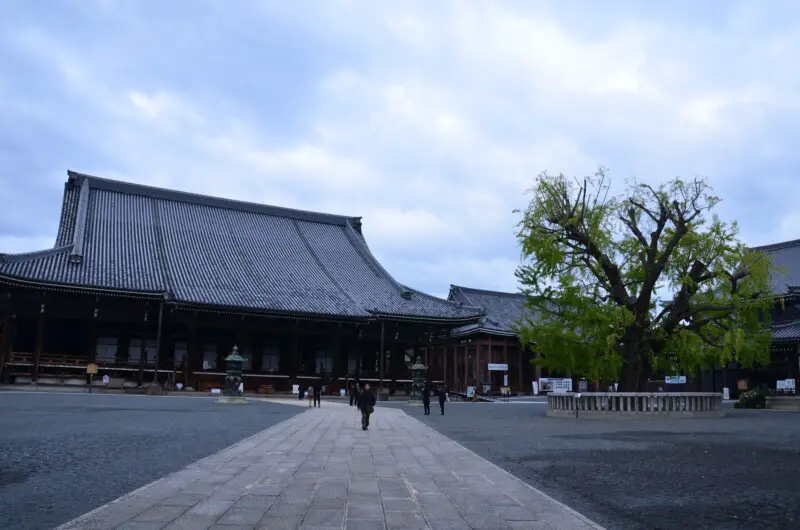
The garden is characterized by its meticulously maintained koi ponds, stone bridges, and traditional tea houses, all accentuated by the brilliant hues of the autumn leaves. How to Reach:
- By Train: The garden is a 10-minute walk from Kyoto Station, making it an easily accessible spot for those transiting through the city’s main transport hub.
Nanzen-ji Temple’s Nanzenin Garden: Overview: While Nanzen-ji Temple is a must-visit, its sub-temple garden, Nanzenin, deserves special mention.
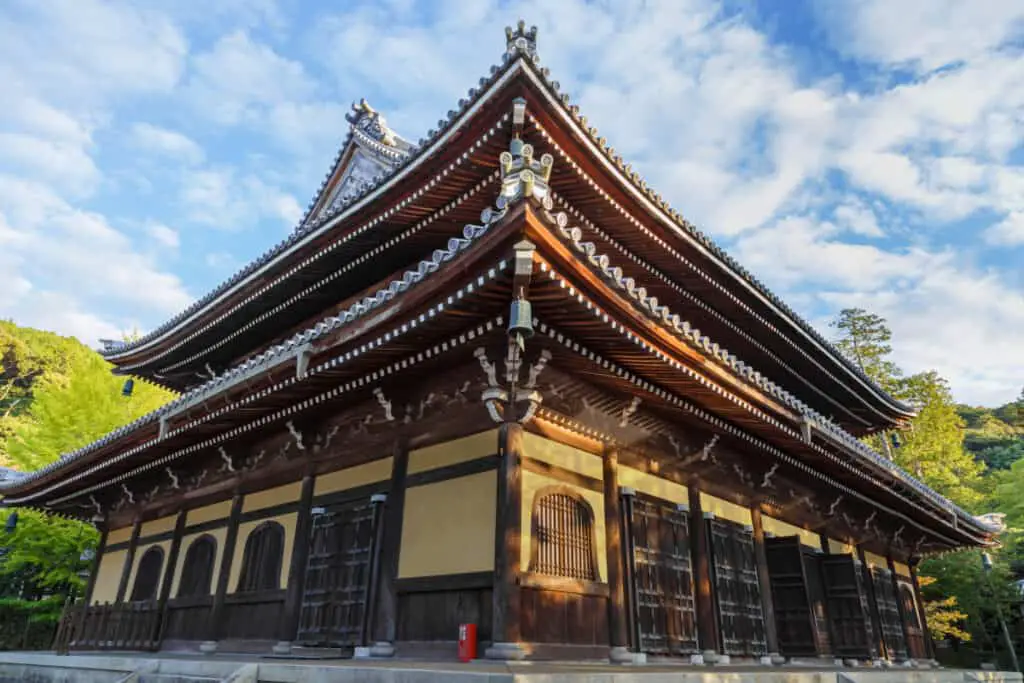
The garden showcases a beautiful moss carpet interspersed with maples and a central pond.
The stone path leading around the pond and the backdrop of the temple structures provide a sense of tranquility, especially amidst the soft autumn colors. How to Reach:
- By Bus: From Kyoto Station, board the City Bus number 5 and alight at the “Nanzen-ji Eikando-michi” stop. Follow the signs to the main temple complex; Nanzenin is located within its precincts.
When visiting these gardens and parks, it’s always a good idea to allow some time for leisurely exploration. Each has its unique features and spots that are best enjoyed at a relaxed pace.
Streets and Alleys
Gion: Overview: Synonymous with the cultural heartbeat of Kyoto, Gion is the city’s historic geisha district.
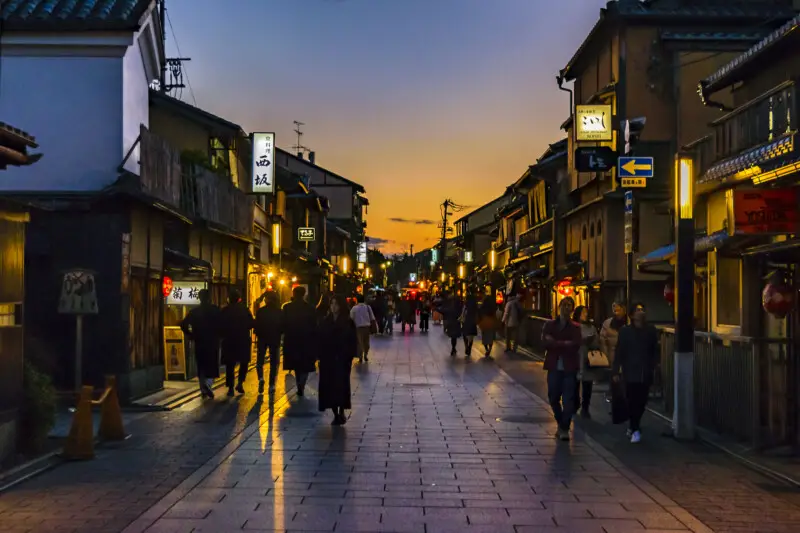
Ancient wooden machiya houses, traditional teahouses, and exclusive ochaya (places where geiko and maiko entertain) are set against a backdrop of autumnal beauty.
The cobblestone streets and lantern-lit pathways are especially enchanting in the evening during the fall season. How to Reach:
- By Bus: From Kyoto Station, take bus number 100 or 206. Alight at the Gion bus stop.
- By Train: Alternatively, the closest train station is Gion-Shijo on the Keihan Line.
Philosopher’s Path: Overview: Named after the philosopher Nishida Kitaro who is said to have used it for daily meditation, this stone path is a peaceful escape.
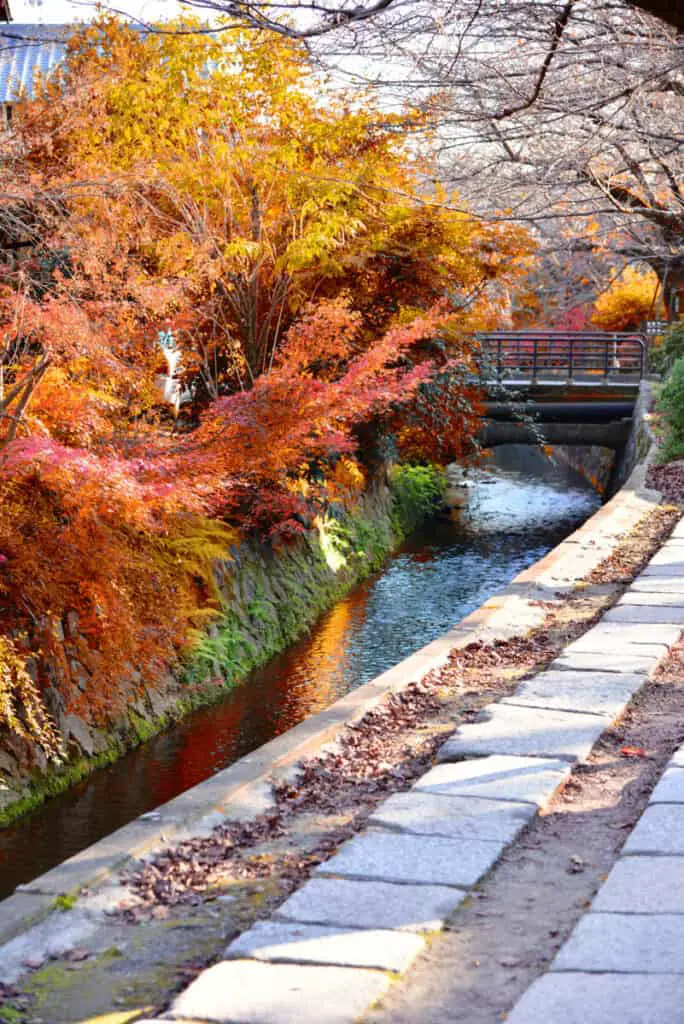
Running beside a canal, the path is lined with hundreds of cherry trees which, come autumn, turn into vivid shades of yellow and red.
Strolling along this path with leaves rustling underfoot and the soft murmur of the canal is an experience many travelers cherish. How to Reach:
- By Bus: Board City Bus number 100 or 203 from Kyoto Station and get off at Ginkaku-ji Michi. The starting point of the path is a short walk from here.
Arashiyama Bamboo Grove: Overview: Known for its towering bamboo stalks that seem to touch the sky, the Arashiyama Bamboo Grove is a sight to behold.
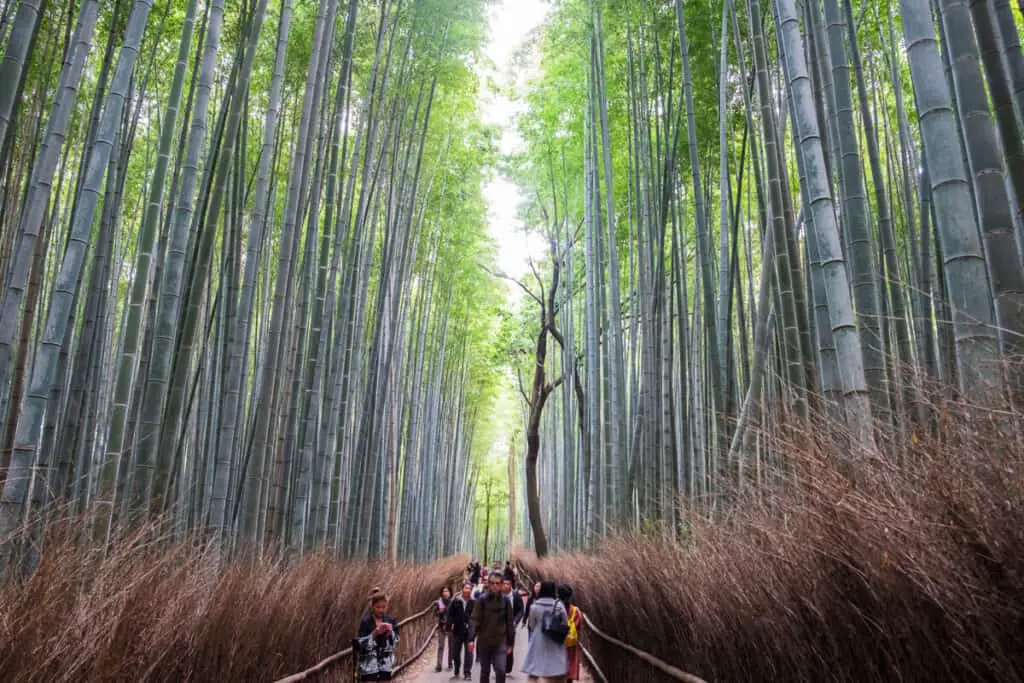
In autumn, while the bamboo remains green, the surrounding area, including the nearby Tenryu-ji Temple and its gardens, burst into a symphony of autumn colors.
This juxtaposition of the perennially green bamboo with the fiery red and orange hues of fall is visually stunning. How to Reach:
- By Train: The JR Sagano Line will get you to Saga-Arashiyama Station from Kyoto Station in about 15 minutes. From the station, it’s a 10-minute walk to the bamboo grove.
- By Bus: City Bus number 28 from Kyoto Station goes to Arashiyama-Tenryuji-mae, which is a convenient stop to explore both the bamboo grove and the temple.
Exploring Kyoto’s streets and alleys during autumn is akin to walking through a living painting. The blend of historic architecture with nature’s palette provides an unforgettable experience.
Palaces and Castles
Katsura Imperial Villa: Overview: As a pinnacle of Japanese traditional architecture and garden design, Katsura Imperial Villa (or Katsura Rikyu) embodies the essence of elegance and harmony.
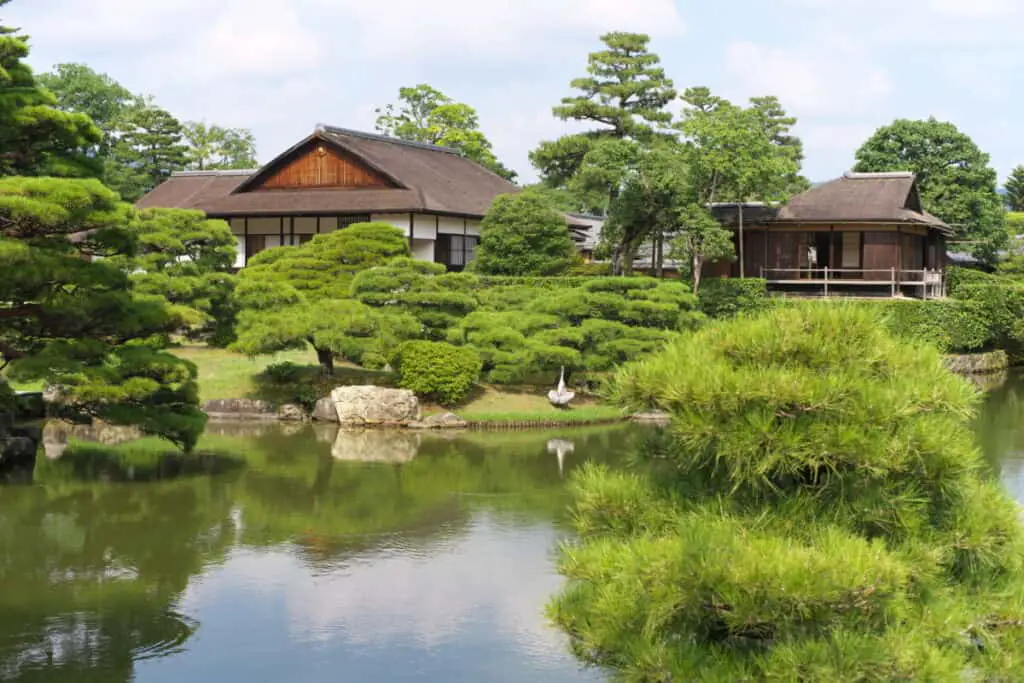
The villa, with its distinct architectural style, is surrounded by a vast strolling garden that offers a myriad of views, which are beautifully enhanced during the autumn season.
The reflections of colorful trees on the villa’s serene ponds add another layer of charm. How to Reach:
- By Train: From Kyoto Station, take the JR Sanin Main Line and get off at Katsura Station. It’s about a 15-minute walk from the station to the villa.
- By Bus: City buses number 33 from Kyoto Station will bring you to the Katsura Rikyu-mae stop. From there, it’s just a short walk to the entrance.
Nijo Castle: Overview: Declared a UNESCO World Heritage Site, Nijo Castle (or Nijo-jo) is celebrated for its “nightingale floors” that chirp when walked upon, its ornate interiors, and its expansive gardens.
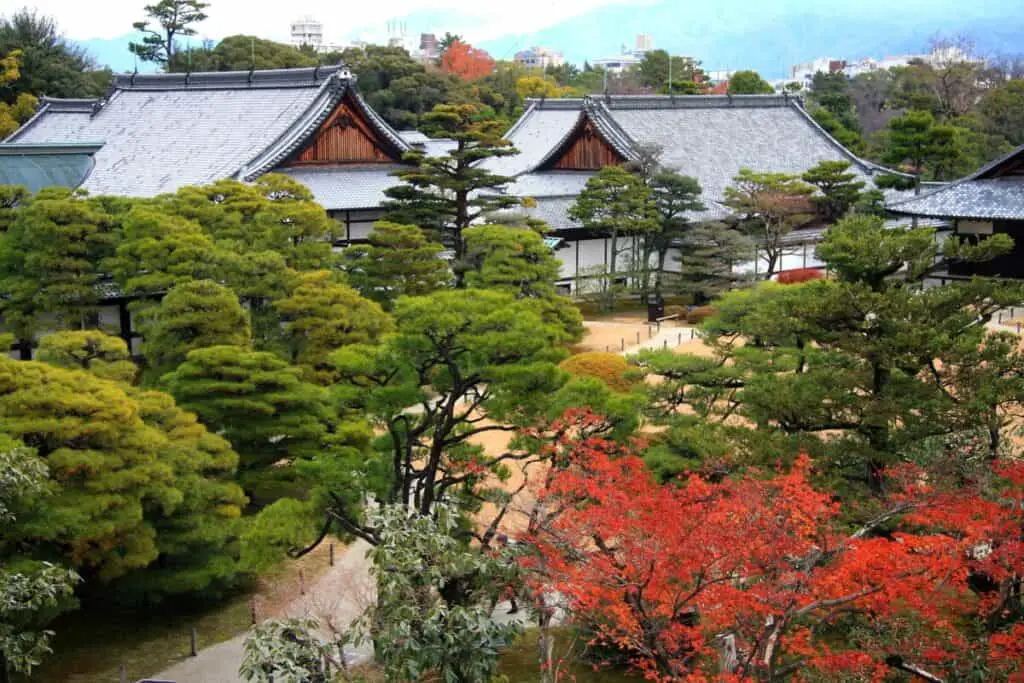
In the fall, the contrast of the castle’s formidable stone walls with the surrounding golden foliage is truly enchanting.
The Ninomaru Garden, with its large ornamental pond, particularly stands out with its reflections of the bright autumn leaves. How to Reach:
- By Train: Nijojo-mae Station on the Tozai Subway Line is the nearest to the castle. It’s only a short walk from the station to the castle’s main entrance.
- By Bus: City Bus number 9, 50, or 101 from Kyoto Station will take you directly to Nijo-jo-mae, the bus stop right in front of Nijo Castle.
Visiting these imperial sites offers not only a journey into Japan’s rich history but also a visual feast, especially during the radiant autumn months.
Tea Houses and Traditional Areas
Pontocho: Overview: One of Kyoto’s most atmospheric dining areas, Pontocho is a narrow alleyway that runs parallel to the Kamo River. Lined with traditional wooden machiya houses, many of them now serve as restaurants and tea houses.
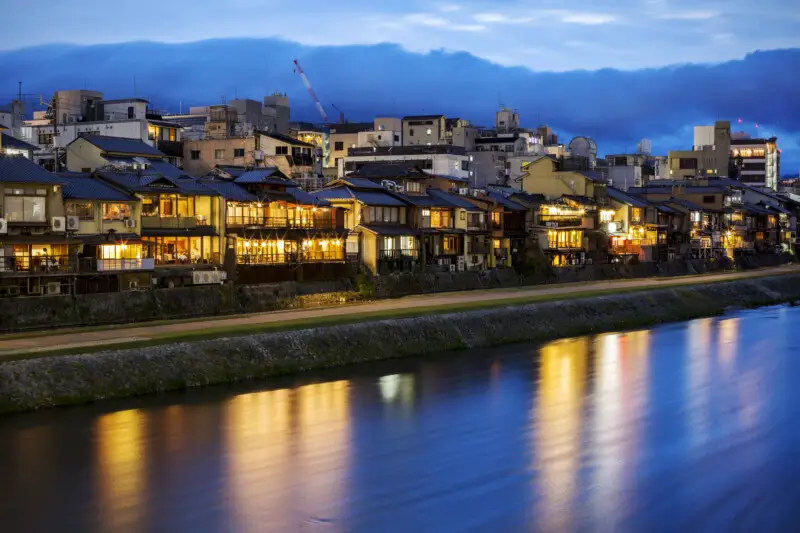
In autumn, these establishments offer the distinct experience of “kawa-yuka” (dining on terraces overlooking the river) with an enchanting backdrop of autumn foliage.
The ambient lights, combined with the season’s vibrant colors, create an unforgettable dining atmosphere. How to Reach:
- By Train: The closest station is Sanjo on the Keihan Main Line, from which it’s a brief walk to the entrance of Pontocho. Alternatively, you can alight at Kawaramachi Station and walk a short distance to reach the alleyway.
- By Bus: City buses number 4, 5, 17, or 205 from Kyoto Station can drop you off at the Shijo-Kawaramachi stop, which is a short walk away from Pontocho.
Ginkaku-ji (Silver Pavilion): Overview: While not covered in silver as its name might suggest, Ginkaku-ji offers its own kind of brilliance.
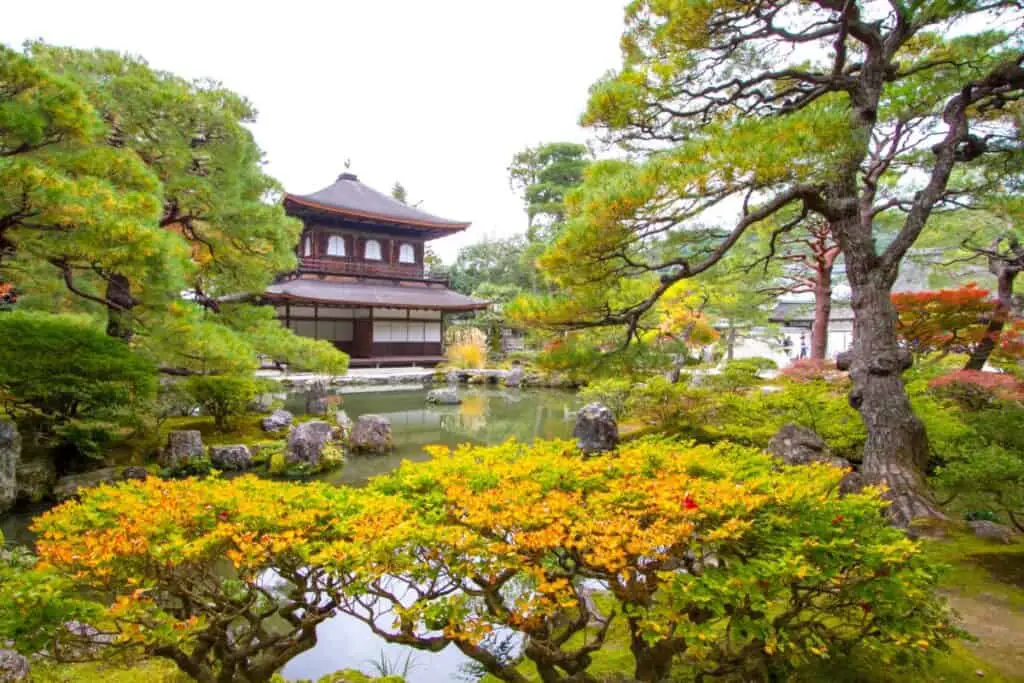
The temple is renowned for its understated beauty, including the sand garden known as the “Sea of Silver Sand,” and the meticulously maintained moss garden.
In autumn, the temple’s gardens are beautifully contrasted by the fiery hues of maple and gingko leaves. This mix of sand, moss, and foliage colors presents a unique tableau. How to Reach:
- By Bus: Board City Bus number 5, 17, or 100 from Kyoto Station and alight at the Ginkaku-ji Michi stop. The entrance to the temple complex is a brief walk from here.
Both Pontocho and Ginkaku-ji showcase Kyoto’s intricate balance of tradition and natural beauty, made even more poignant by the brushstrokes of autumn.
Whether you’re savoring a meal by the river or reflecting in the quiet gardens of the Silver Pavilion, the essence of Kyoto in fall awaits your discovery.
Mountains and Natural Landscapes
Mt. Hiei: Overview: Towering over Kyoto and Lake Biwa, Mt. Hiei offers a refreshing escape from the city’s hustle and bustle. Enryaku-ji Temple, a UNESCO World Heritage site, is located on its slopes.
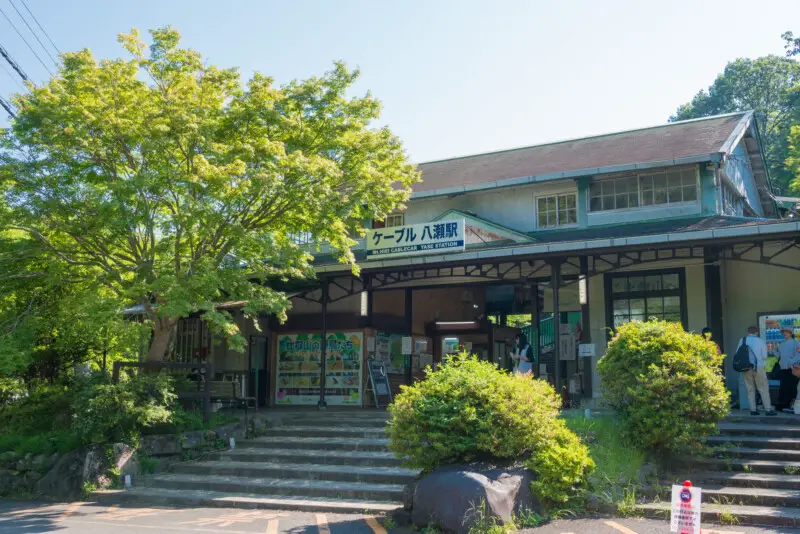
Eizan Cable to Mt. Hiei
In the autumn, the mountain becomes a canvas painted with fiery reds, yellows, and oranges. A ride on the cable car provides panoramic views of the Kansai region, blanketed in these autumnal hues. How to Reach:
- By Cable Car: From Kyoto, take the Keihan Railway to Demachiyanagi, then transfer to the Eizan Railway. Alight at Yase-Hieizanguchi Station, from where you can take the Eizan Cable to Mt. Hiei.
Otagi Nenbutsu-ji Temple: Overview: Located in the scenic Arashiyama district, Otagi Nenbutsu-ji is famed for its 1200 stone statues of Rakan (Buddhist disciples), each with unique facial expressions.
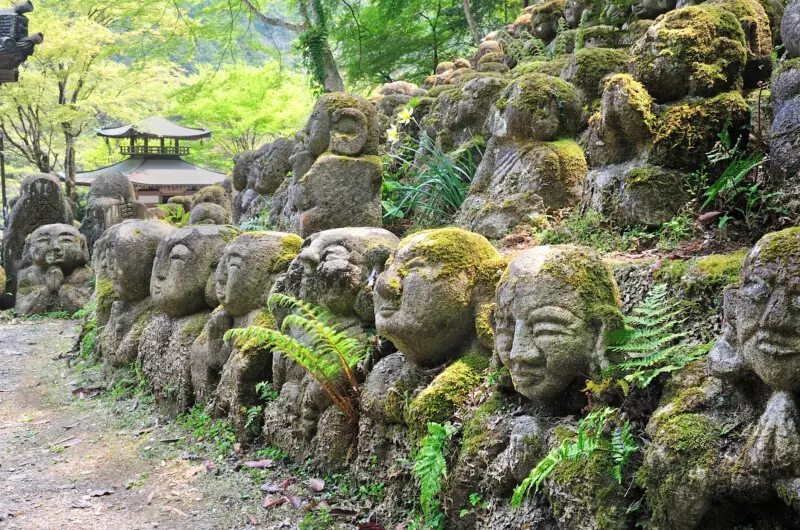
These stone figures, coupled with the dazzling backdrop of autumn leaves, create a surreal and enchanting atmosphere. How to Reach:
- By Bus: From Arashiyama, buses frequently run to Otagi Nenbutsu-ji. Alternatively, if you’re up for a scenic walk, it’s about a 30-minute journey on foot from the main area of Arashiyama.
Kurama: Overview: Located north of Kyoto, Kurama is a small town best known for its temple, Kurama-dera, and its rejuvenating hot springs, Kurama Onsen.
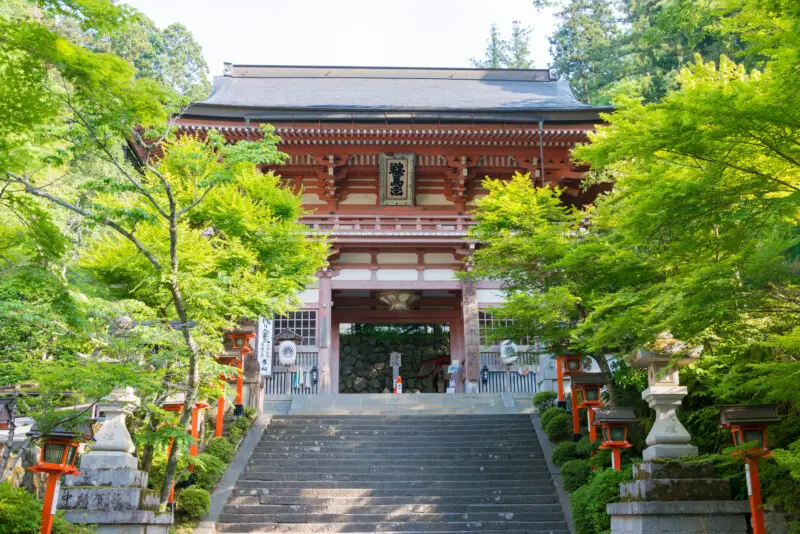
In autumn, the town and its surrounding mountainsides are awash with vibrant fall colors, adding an extra layer of serenity to the hot spring experience. How to Reach:
- By Train: From Demachiyanagi Station in Kyoto, take the Eizan Railway to its last stop, Kurama. The journey offers beautiful scenic views, especially during autumn.
Each of these locations offers a unique perspective on Kyoto’s natural beauty, especially highlighted during the autumn season.
Whether you’re seeking panoramic views, the mystique of ancient statues, or the relaxation of a hot spring surrounded by vibrant foliage, these mountains and landscapes promise unforgettable experiences.
Modern Attractions
Kyoto Tower: Overview: Standing as a beacon of modernity amidst the historic backdrop of Kyoto, Kyoto Tower offers a panoramic view of the city, its temples, and surrounding mountains.
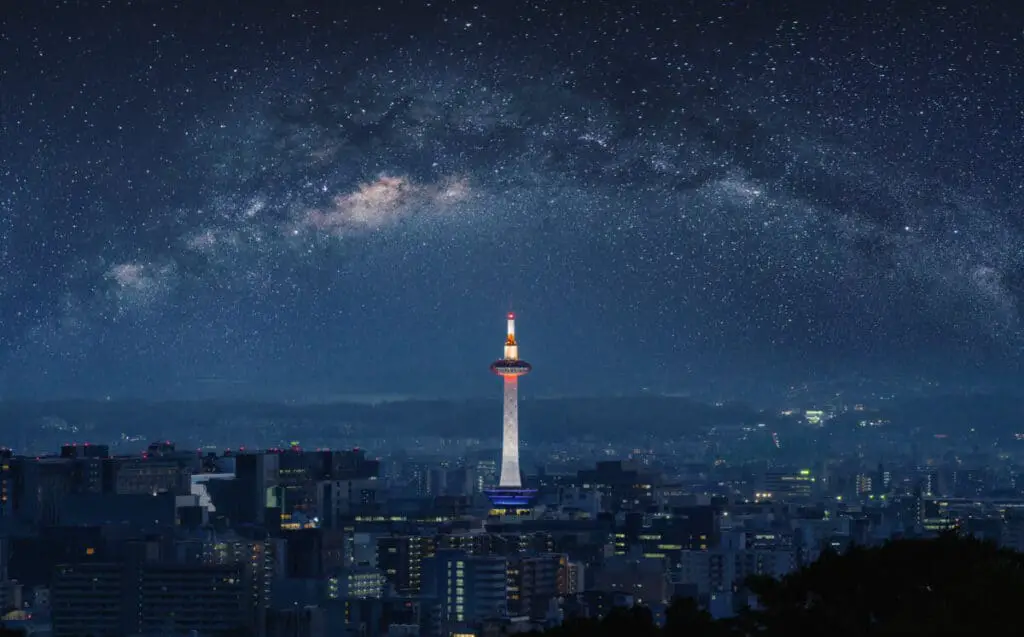
In autumn, the view from the observation deck transforms, with pockets of vibrant reds, oranges, and yellows dotting the cityscape, creating a beautiful contrast with the urban environment. How to Reach:
- By Train: Kyoto Tower is directly opposite Kyoto Station, which is the city’s main transportation hub. Simply exit the station and the tower is within a few minutes’ walk.
Kyoto International Manga Museum: Overview: A mecca for manga enthusiasts, the Kyoto International Manga Museum houses a vast collection of manga, spanning various eras and genres.
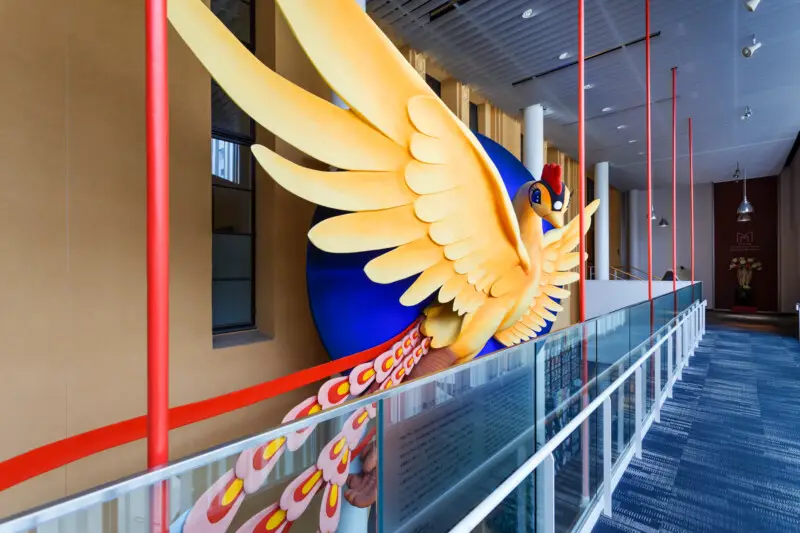
Its walls lined with manga are known as the “Manga Wall,” offering visitors a chance to dive deep into Japanese comic culture.
The museum’s courtyards and surrounding areas are adorned with trees that, in the autumn season, complement the indoor experience with a vibrant outdoor ambiance. How to Reach:
- By Subway: The museum is about a 5-minute walk from Karasuma-Oike Station on the Karasuma Subway Line.
- By Bus: Multiple city buses serve the museum. The closest bus stop is “Karasuma-Oike,” which is well-connected to Kyoto Station and other major points in the city.
These modern attractions showcase a different facet of Kyoto, blending the contemporary with the traditional.
While they offer a departure from ancient temples and shrines, the essence of Kyoto’s autumn beauty remains ever-present, ensuring a comprehensive experience for travelers.
Festivals and Events
Jidai Matsuri (The Festival of Ages): Overview: One of Kyoto’s three major annual festivals, the Jidai Matsuri is a grand procession that celebrates the city’s illustrious history.
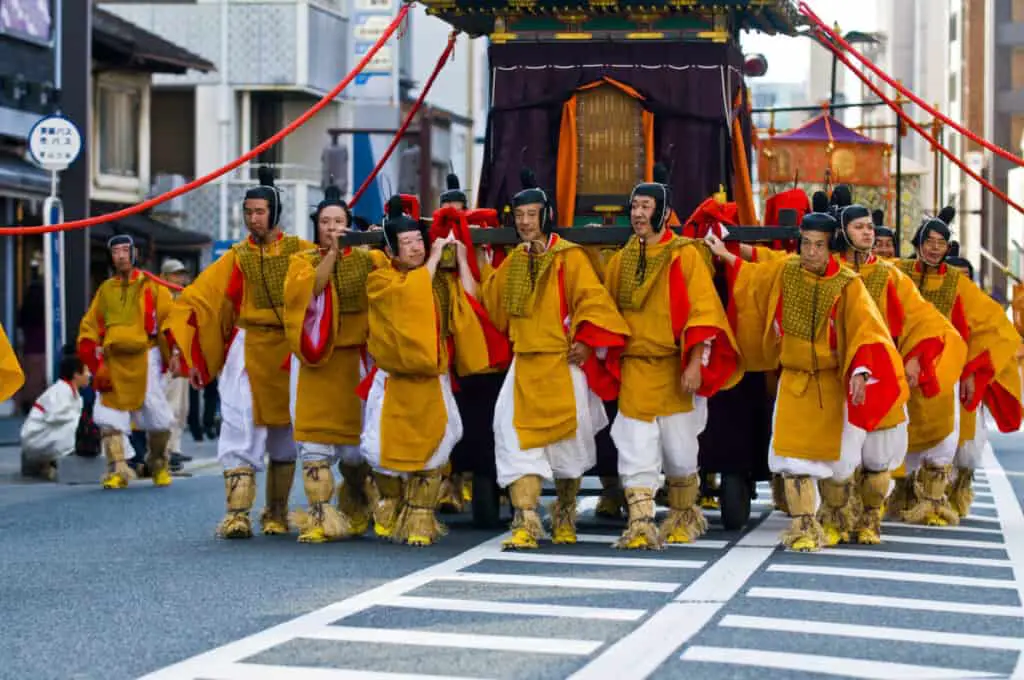
Participants dressed in authentic costumes from different eras of Japanese history march from the Imperial Palace to Heian Shrine, showcasing a living timeline that spans centuries.
Held in late October, the festival sometimes coincides with the onset of the autumn foliage, making it a vibrant spectacle against the backdrop of the season. How to Experience:
- Location: The parade starts at the Kyoto Imperial Palace and concludes at Heian Shrine.
- Timing: Late October, often on the 22nd.
Kurama Fire Festival (Kurama no Hi-Matsuri): Overview: Held in the mountain village of Kurama, this festival is an energetic display of fire, spirit, and tradition.
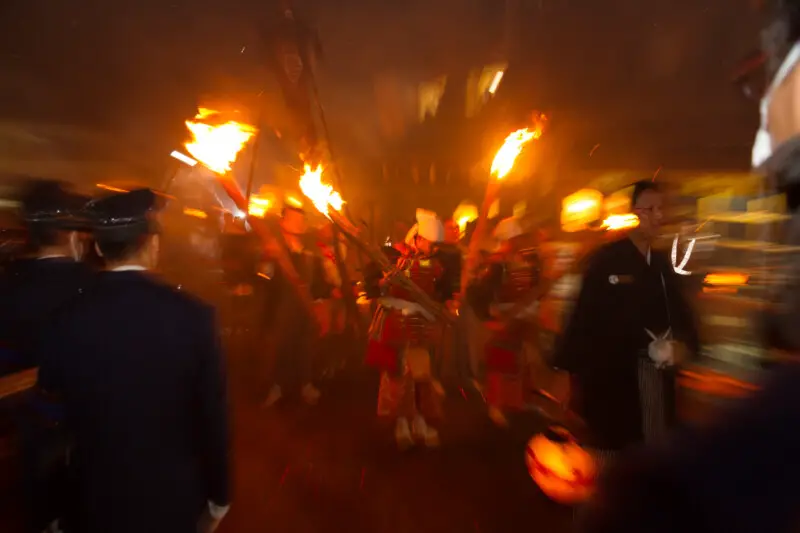
As night falls, participants carry large torches through the streets, with the main event being the procession of mikoshi (portable shrines) amidst flames and chants.
The fire symbolizes the welcoming of spirits to the human realm. Visiting during autumn adds an extra layer of ambiance with the cool air and colorful leaves. How to Experience:
- Location: Kurama Village, north of Kyoto.
- Timing: October 22nd, every year.
Arashiyama Momiji Festival: Overview: Celebrated in the scenic district of Arashiyama, this festival is a tribute to the breathtaking beauty of autumn leaves.
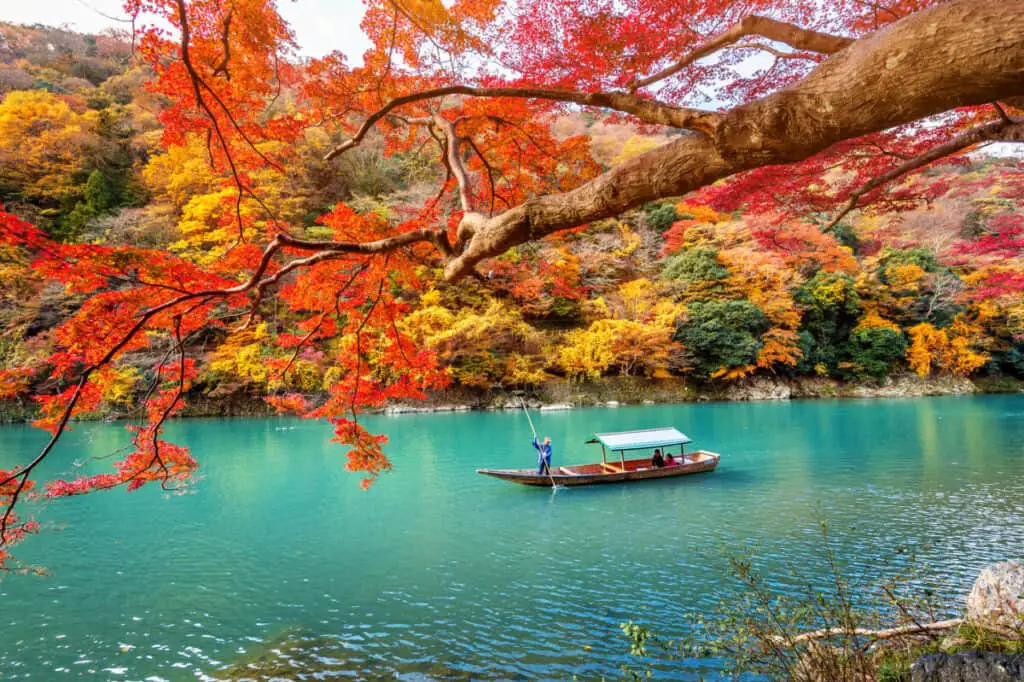
The highlight is a reenactment of the Heian Period court life, with participants dressed in period costumes, performing traditional music and dances on boats that float on the Oi River.
The rich autumn hues from the surrounding trees reflecting on the water make it a picturesque event. How to Experience:
- Location: Arashiyama district, along the Oi River.
- Timing: Mid-November, typically on the second Sunday of the month.
Experiencing these festivals offers travelers a deep dive into Kyoto’s traditions, beautifully amplified by the ambiance of the autumn season.
The blend of history, culture, and nature promises memories that last a lifetime.
Unique Experiences
Autumn Illuminations at Kodai-ji: Overview: Nestled in the Higashiyama district of Kyoto, Kodai-ji Temple takes on a magical transformation during the autumn season with its special nighttime illuminations.
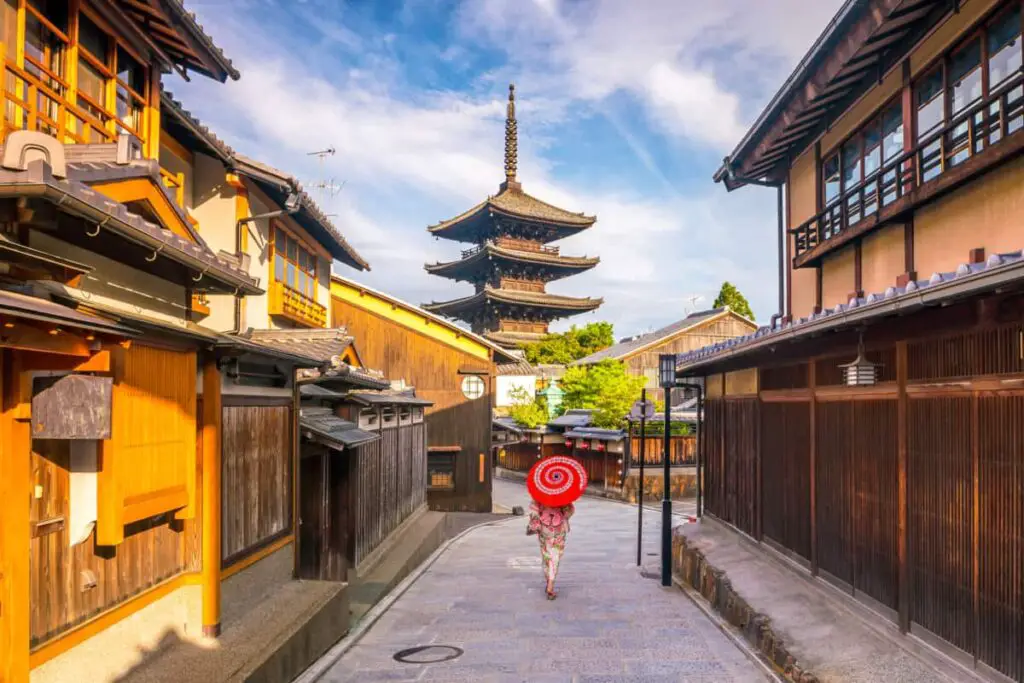
As the sun sets, strategically placed lights illuminate the vibrant red and orange hues of the maple trees, contrasting beautifully with the darkening sky.
The reflection pond within the temple grounds further amplifies the beauty, capturing the illuminated autumn leaves in its serene waters.
Coupled with the temple’s traditional architecture and zen gardens, this event offers a surreal, dreamlike experience, showcasing autumn in Kyoto like nowhere else. How to Experience:
- Location: Kodai-ji Temple, Higashiyama district.
- Timing: The illumination typically starts in mid-October and lasts until early December, with the event open from sunset until 9:30 pm.
- Getting There: The temple is a short walk from the nearest bus stop, Higashiyama Yasui, which is well-connected to Kyoto Station and other major points in the city.
Engaging with the autumn illumination at Kodai-ji is not just about witnessing the beauty of the season, but also feeling the profound connection between nature, tradition, and artistry that epitomizes Kyoto.
Summary Of Kyoto In Autumn
There’s a sublime sort of alchemy that happens in Kyoto during autumn. The ancient temples, shrouded in centuries of history, are juxtaposed against the ephemeral beauty of fall leaves.
It’s a testament to the impermanence celebrated in much of Japanese culture – that beauty often lies in fleeting moments, and there’s profound meaning to be found in nature’s transitions.
Experiencing autumn in Kyoto feels like walking through a living painting, where every hue – from the deepest reds to the most luminous golds – tells a story.
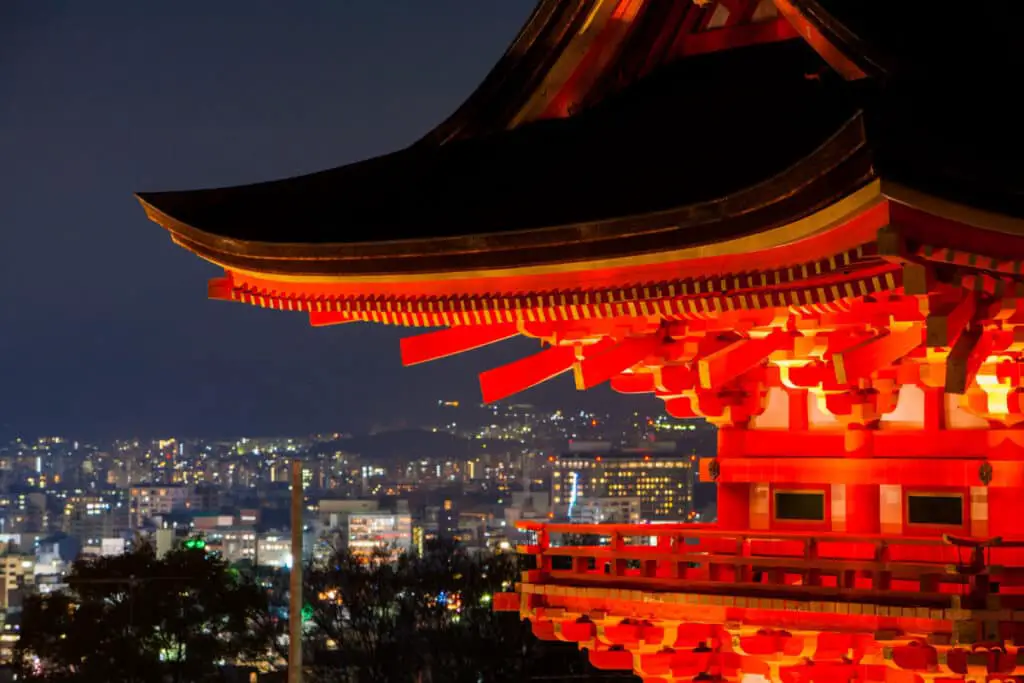
The leaves rustling underfoot in Maruyama Park, the shimmer of the evening illuminations at Kodai-ji, or the distant echo of a temple bell on a crisp morning; these are not just sensory experiences, but moments of profound connection with a city that has celebrated the beauty of nature for millennia.
However, with such beauty comes responsibility. As travelers, we’re privileged to witness the tapestry of Kyoto’s autumn, but this privilege brings with it an obligation.
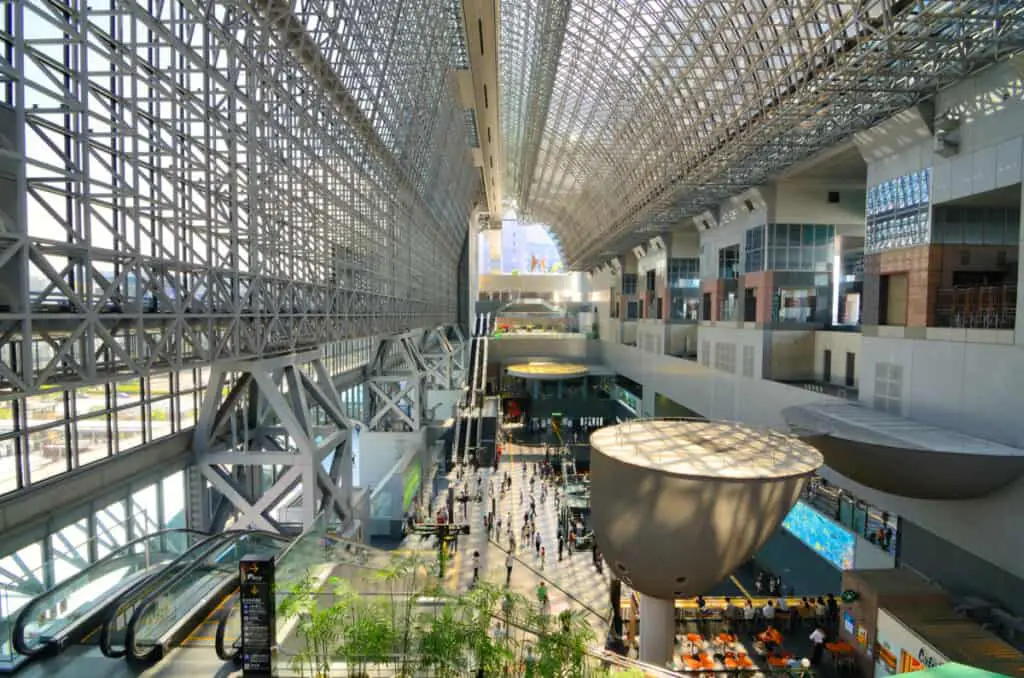
The footprints we leave behind – both literal and metaphorical – have an impact.
Sustainable tourism is not just a buzzword; in cities like Kyoto, it’s a necessity. As the influx of visitors grows, it’s crucial to travel responsibly.
This means respecting the local customs, traditions, and etiquettes. It’s about understanding that the ancient tea houses, the delicate moss gardens, or the tranquil temple corridors are not just tourist attractions, but living, breathing embodiments of a culture.
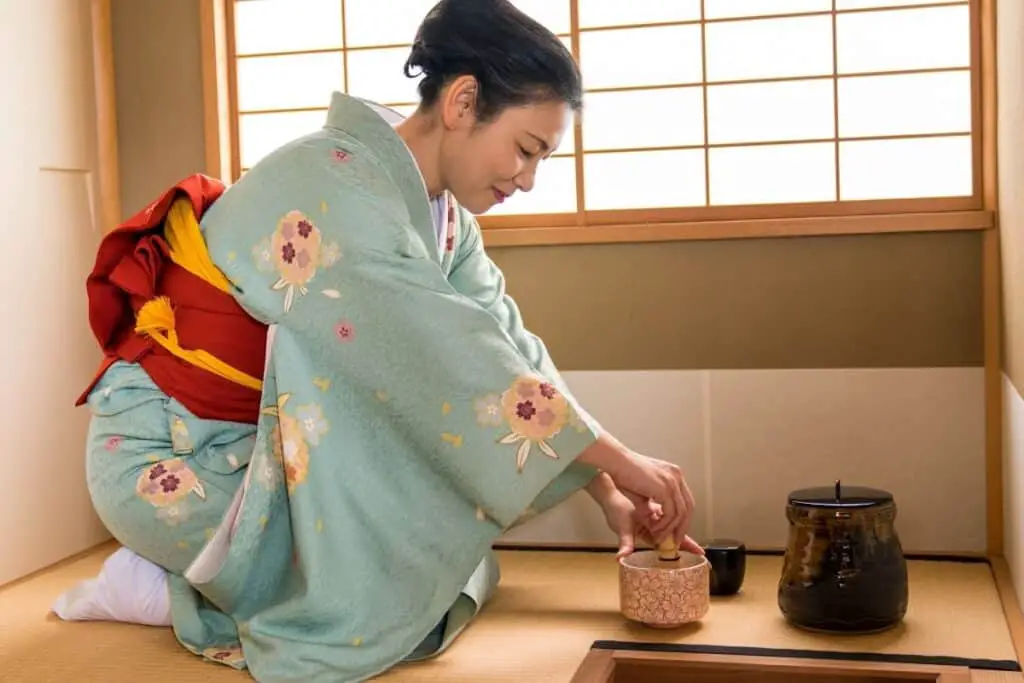
Traveling sustainably also extends to our interactions with the environment. Using public transport, minimizing waste, respecting designated paths, and refraining from picking leaves or flowers ensures that the beauty of Kyoto’s autumn can be preserved for generations to come.
Kyoto, in all its autumnal glory, is a gift. It’s a reminder of the delicate balance between man, culture, and nature.
As the seasons shift and the leaves fall, let’s ensure that our travels leave behind memories, not scars.
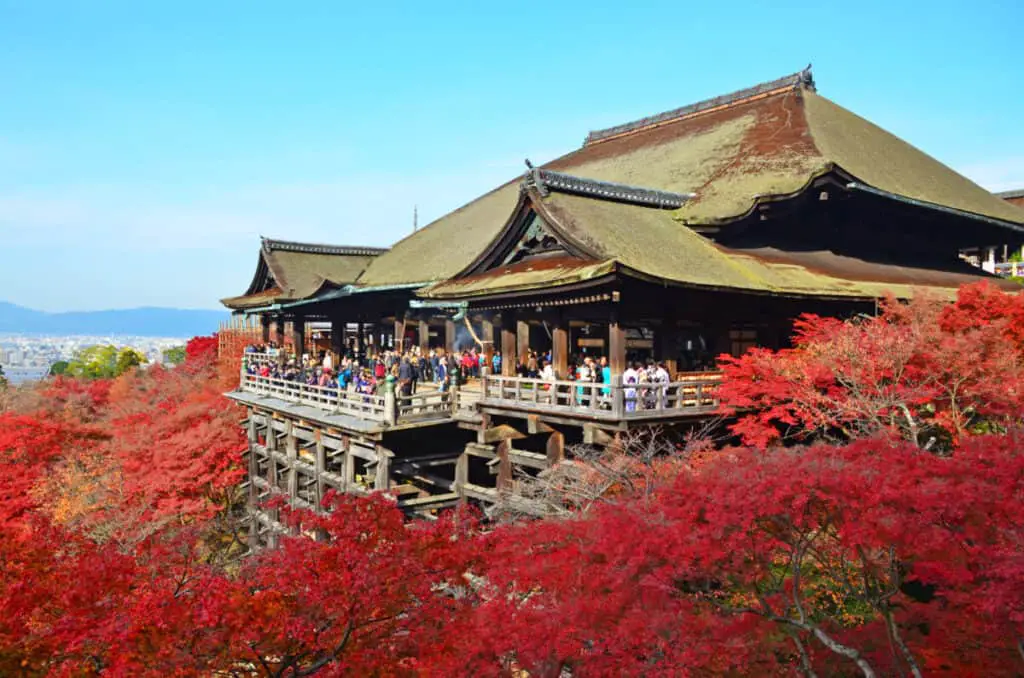
Let’s cherish and protect, so that years from now, another traveler can stand under the same maple tree, awestruck, feeling the same profound connection to a city that timelessly weaves nature into its very soul.
Here’s a comprehensive list of the 25 locations mentioned, each with its associated website
Temples and Shrines:
- Kiyomizu-dera Temple: Website
- Tofuku-ji Temple: Website
- Eikando Zenrin-ji Temple: Website
- Rurikoin Temple: Website
- Daigo-ji Temple: Website
- Shimogamo Shrine: Website
Gardens and Parks: 7. Maruyama Park: Official Kyoto Page
Streets and Alleys: 10. Gion: Official Kyoto Page
- Philosopher’s Path: Official Kyoto Guide
- Arashiyama Bamboo Grove: Official Kyoto Guide
Palaces and Castles: 13. Katsura Imperial Villa: Official Imperial Household Agency Page
- Nijo Castle: Website
Tea Houses and Traditional Areas: 15. Pontocho: Official Kyoto Guide
- Ginkaku-ji (Silver Pavilion): Website
Mountains and Natural Landscapes: 17. Mt. Hiei: Official Tourism Page
- Otagi Nenbutsu-ji Temple: Official Kyoto Guide
- Kurama: Official Kurama Page
Modern Attractions: 20. Kyoto Tower: Website
- Kyoto International Manga Museum: Website
Festivals and Events: 22. Jidai Matsuri: Official Festival Page
- Kurama Fire Festival: Kurama Village’s Official Guide
- Arashiyama Momiji Festival: Official Arashiyama Tourism Site
Unique Experiences: 25. Autumn Illuminations at Kodai-ji: Website


